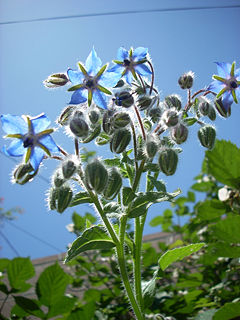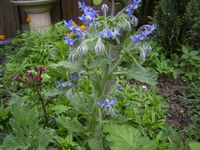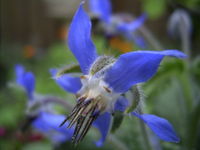Borage
2008/9 Schools Wikipedia Selection. Related subjects: Plants
| Borage | ||||||||||||||
|---|---|---|---|---|---|---|---|---|---|---|---|---|---|---|
 Borage flower
|
||||||||||||||
| Scientific classification | ||||||||||||||
|
||||||||||||||
| Binomial name | ||||||||||||||
| Borago officinalis L. |
Borage (Borago officinalis L.), also known as "starflower" (گل گاوزبان in Persian) is an annual herb originating in Syria, but naturalized throughout the Mediterranean region, as well as most of Europe, North Africa, and Iran. It grows to a height of 60-100 cm (2-3 feet), and is bristly or hairy all over the stems and leaves; the leaves are alternate, simple, and 5-15 cm (2-6 in) long. The flowers are small and normally blue, although they may be pink or white, with five narrow, triangular-pointed petals. It has an indeterminate growth habit allowing it to produce many seeds which may lead to prolific spreading. In milder climates, borage will bloom continuously for most of the year.
Characteristics and uses
The leaves have been found to contain small amounts (10 ppm of dried herb) of the liver-toxic pyrrolizidine alkaloids: intermedine, lycopsamine, amabiline and supinine. They taste like fresh cucumber and are used in salads and soups especially in Germany. One of the better known recipes with borage is the Green Sauce made in Frankfurt. Frankfurter Grüne Sauce, as it is called in Germany, is made from seven herbs: parsley, chervil, chives, cress, sorrel, burnet and borage. Borage is also an ingredient in the traditional recipe for a Pimm's Cup. It's also commonly eaten in the Spanish regions of Aragón and Navarra. One of the simplest recipes uses winter grown borage (because these have grown slowly and taste better) and before flowers appear (although not mandatory), typically cooking it in boiling water with a pair of potatoes. Once plated, the vegetables are seasoned with a little olive oil and salt.
The flower, which contains the non-toxic pyrrolizidine alkaloid thesinine, has a sweet honey-like taste and, being one of the few truly blue-colored edible things, is often used to decorate desserts and dishes.
Tea made from the dried flowers is a traditional calming drink in Iran. It has a rich purple colour that turns bright pink by adding a few drops of lemon juice.
Interest in borage remains high because it is the highest known plant based source of gamma-linolenic acid (18:3, cis 6,9,12-octadecatrienoic acid). The seed oil is often marketed as "starflower oil" or "borage oil."
Borage is also rich in oleic and palmitic acid, conferring a hypocholesterolemic effect. This oil, which has recently been commercialised, may regulate metabolism and the hormonal system, and is considered by many naturopathic practitioners to be a good remedy for PMS and menopause symptoms such as the hot flash. Borage is also sometimes indicated to alleviate and heal colds, bronchitis, and respiratory infections in general for its anti-inflammatory and balsamic properties. The flowers can be prepared in infusion to take advantage of its medicinal properties.

